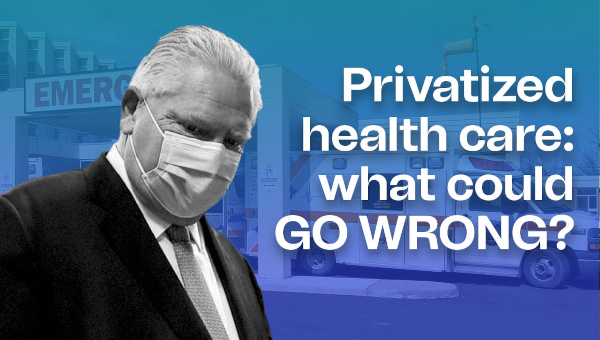The Coming Battle: Healthcare Privatization and the Ontario Election
In the past, capitalists had given many aspects of healthcare a pass in Canada and Ontario. There was a general preference to leave medicare intact from the lower costs it provided employers, especially in export sectors like auto, that gave Canadian companies a cost advantage. But, with the shifting balance of class power and the turn to an ‘age of austerity’ in the midst of the economic crisis, this has changed. With cuts to public healthcare set for the post-election period in Ontario whatever the electoral outcome, that balance is poised to change again with further attempts to privatize and marketize the healthcare system.
The 1990s: Origins of Healthcare Privatization
In the early 1990s, delivery of healthcare in Ontario by for-profit businesses had been centred in the long term care and ambulance industries. Even hospital support services were mostly publicly delivered. Public insurance sufficed for hospital and physician services.

During the hard right government of Conservative Mike Harris, there was a significant development of for-profit long term care facilities. The Harris government also embarked on two other major attempts to privatize healthcare: [1] the creation of public-private partnership (P3) hospitals where for-profit corporations would finance new hospital facilities and operate the hospital support services, and [2] the establishment of for-profit diagnostic clinics for MRIs and CT scans.
Long running community-labour campaigns led by the Ontario Health Coalition helped to delay the expansion of for-profit diagnostic clinics. They also limited the privatization of support services in P3 (public-private partnership) hospitals, even while the private financing for these hospitals continued unabated. As well, with the assistance of a union campaign, for-profit delivery of ambulance services was mostly abolished. The latter was accompanied by a dramatic improvement in the pay and prestige of paramedics, along with the quality of Emergency Medical Services.
The Role of International Capital in Healthcare Privatization
International capital played a major role in the various privatization ventures, with the expertise on privatization of British corporations from the Margaret Thatcher era most evident. Carillion, a British P3 corporation won a major role in the first two projects started by the Harris government, massively expanding its role in Canada. The role of international capital has been a major theme in recent healthcare privatization initiatives across Canada.
In British Columbia, the election of the business government of Gordon Campbell in 2001 led to one of the biggest privatizations in Canadian history. Support work performed by thousands of employees at healthcare facilities was contracted out. The work went largely to foreign based transnational corporations. Indeed, following complaints about superbug infections, the Vancouver Island Health Authority tried to dump its transnational housekeeping contractor earlier this year, but Compass hung on to its $50-million, five-year deal by buying Marquise Group, the company chosen to take over cleaning at several Island facilities. “It’s always a bit disconcerting when you set a contract with one company and another company buys them,” observed Joe Murphy, vice-president of the health authority’s operations.
The consortia for a new, massive P3 hospital in Montreal is entirely foreign: Innisfree, a British based firm which is one of the largest investors in hospitals around the world; Laing O’Rourke Canada Ltd., a British based construction firm; OHL Construction Canada Ltd., a Spanish construction and services groups; and Dalkia, a large French company that provides facilities management services to more than 5,000 hospitals around the world. Dalkia has also recently built a plant in Ontario to sterilize hospital surgical instruments through a subsidiary of one of its subsidiaries.
Canadian capital has been forming its own interests in privatization, but these national capitals have historically had less P3 experience than competing foreign corporations in the healthcare sector. The long term financing aspect of the deals particularly disadvantage Canadian companies, whose relatively smaller size weakens their ability to secure financing at favourable rates. These changes are bringing powerful international capitalist interests to the healthcare industry in Canada, but also providing a foundation for Canadian capital to grow and develop their own agenda for internationalization.
So, for example Bombardier, a relatively large Canadian corporation, lost its position as the favourite for a £1-billion Crossrail train contract when the government moved to fund the deal through a P3. The problem? Bombardier’s German based competitor, Siemens, has better access to financing than Bombardier. “A large company like Siemens will be able to borrow the money to undertake a project of this kind,” Tony Travers, director of the Greater London Group at the London School of Economics, warned. Indeed, Siemens’s superior financial power is thought to have been a factor in their victory over Bombardier for a recent Thameslink deal that caused Bombardier to announce it would lay off 1,400 workers at a British factory.
Certainly foreign corporations are often the winners of major healthcare privatizations so far in Canada: think of Carillion, Compass, Sodexho, and Aramark. Likely, the giant foreign trans-nationals will have a marked ability to push for and capitalize on new major privatization initiatives. A significant point – if the openings for privatization become more widespread. But more P3 activity in Canada will also help some Canadian capitalists in the healthcare sector gain additional productive capacity and financial expertise and linkages to compete more successfully. The internationalization of capital is a key dynamic to healthcare sector restructuring and it bears close watching in Canada.
Privatization of Clinical Services
While in the past, the privatization initiatives had steered to less controversial quarters, the privatization of surgical and diagnostic services has come more to the fore.
For example, Sacre-Coeur hospital in Montreal has moved 6,000 surgeries to the private business RocklandMD since 2008. In this case, however, the private surgical clinic is not just performing a few minor surgeries. Instead it is performing breast cancer operations, bariatric surgery, orthopaedic surgery, etc. RocklandMD claims to be able to perform a broad range of day surgeries, “from the simplest to the most complex, in various specialities and within very short times.”
In contrast, the Toronto Star has noted that the Quebec Health Insurance Board reprimanded a Rockland MD for charging patients fees for use of medical equipment, facilities and support staff in contravention of the Canada Health Act. This is a new and troubling level of healthcare privatization in Canada. The thin edge of the wedge is usually to start with support services, minor operations or tests. The corporations are now pushing to go well beyond that.
Physicians have been a factor in these developments, with the Ontario Medical Association leading the calls for an expansion of private surgical and diagnostic clinics. The doctors have actually already achieved enormous increases, driving up their OHIP funding since the Liberals got in power by just under $6-billion – an astonishing 87 per cent increase! That one line-item increase alone accounts for a significant portion of the total increase in healthcare spending in Ontario.
But more came through special funding for private clinics, or “Independent Health Facilities.” The Conservatives explicitly called for the expansion of private clinics in the 2007 provincial election, to little electoral avail. The Liberals declined to make such a call and opposed the for-profit CT and MRI clinics established by the Harris government.
In fact, the private clinics have seen an 82 per cent increase during the Liberal regime. Outgoing Liberal Health Minister Deb Matthews responded to the latest demands from the doctors for more funding for the private clinics by saying: “We’re not opposed… We support the need to deliver services in the community. That’s why we have a lot more dialysis, for example, out of hospitals. It’s really all about getting the right balance.” As these clinics expand the fragmentation of the healthcare system grows and the problems of recruitment and retention of professional staff at public facilities increases.
Privatized Payments for Healthcare
With the development of for-profit clinics, we also get a push for new revenue to increase profits. This often means user fees – or what the World Health Organization refers to as by far the major obstacle to progress toward universal coverage.
The MRI and CT private clinics established by the Progressive Conservatives were founded on this idea, as are many of the private clinics popping up around the country. Many private clinics are introducing user fees, some quite ingenious to get around legal obstacles (e.g. $100 for a glass of orange juice – I kid you not). As corporations get in on this action, they will likely prove much more formidable backers of this than the physicians alone.
Ontario Leads the Way
Contrary to pro-privatization myth-makers, Canada is not a backwater of socialized healthcare akin to Cuba. About 29.8 per cent of Canadian healthcare expenditure comes from private (rather than public) payments. That’s a lot of user fees for those without private insurance. In fact, Canada rates 18th out of 26 developed countries reported by the Canadian Institute for Health Information (CIHI). Other measures also bear this out. Private healthcare payments account for 3.1 per cent of the Canadian GDP, tied for the fourth highest percentage of the 26 countries reported by CIHI. In fact, Canadians make the third highest payments for private healthcare services in the world ($1,216 in 2008).
No surprise, Ontario has higher private payments than any other province both as a percentage of total healthcare expenditures (32.6 per cent of total healthcare expenditures) and in total cash payments per capita ($1,841 per person). For total cash payments, that’s 50 per cent more than Canada as a whole.
A Perfect Storm?
Increased costs for Canadian public healthcare are a pale echo of the increased costs in the motherland of privatization, the USA. Americans have faced 113 per cent premium increases for employer-based plans over the last ten years (a 108 per cent increase for the employers’ share and a 131 per cent increase for the workers’ share of those premiums).
While the Ontario Ministry of Health and LTC got significant funding increases over the last ten years, those increases fall well short of this enormity. A 113 per cent increase would have forced Ontario to come up with an additional $11-billion this year alone.
Americans now face an average premium for family coverage of $15,073 (U.S.) annually. U.S. private insurance now also provides less comprehensive coverage: “Without any real national discussion or debate, there’s a quiet revolution going on in what we call health insurance in this country,” Drew Altman, president of the Kaiser recently told the Washington Post. “Health insurance is becoming less and less comprehensive. … And we expect that trend to continue.” And with the increased costs, fewer employers even offer healthcare insurance: it’s now down to 60 per cent from 68 per cent a decade ago. In fact 12.6 million Americans fell off of employer-based plans over the last decade, with a drop of 1.5 million in 2010 alone.
Nevertheless, the increased costs in Canada have been significant, with 6 per cent annual increases in federal payments in the current ten year deal for the Canada Health Transfer and an average 6.6 per cent annual increase in Ontario for the Ministry of Health and LTC funding over the last ten years.
And there are significant service problems: dramatically increased wait times for long term care, 10,000 people on wait lists for home care, sky high hospital bed occupancy, back-ups in emergency rooms, ambulance offload delays at overcrowded emergency rooms, and, when it all backs up, code zeroes (when there are no ambulances available to respond to 911 calls).
Ontario has significant provincial deficits and the prospect of more economic troubles is clearly possible. The response of the Ontario government, like other Canadian governments of a wide variety of political stripes, has so far been to turn to austerity and squeeze provincial funding after the October election.
The widely accepted plan is to eliminate the provincial deficit by 2017-18. A few months ago, the Auditor General reviewed the Liberal healthcare funding plan for the next two years and reported that those increases would average 3.6 per cent annually. This is much less than previous years (about half) and the Auditor was openly sceptical that the government could implement this without significant healthcare cuts, even with a wage freeze. Hospitals for example “may have little alternative but to cut services.” For an auditor, these are strong words.
But even this dismal projection may prove optimistic. Buried in the costing of their electoral program, the Liberals have determined that they won’t even meet this level of funding. They will only increase healthcare funding by 3.6 per cent next year. The year after that the increase will fall to 2.86 per cent, a decline of 0.74 per cent. This will mean the loss of $360 million dollars in healthcare funding annually.
The two-year average annual increase will be 3.2 per cent rather than 3.6 per cent. The Liberal four year increase would also be about 3.2 per cent annually, based on figures in their costing document. For the Conservatives, the increases would be about the same. This contrasts with promises from the federal government to increase their transfers for healthcare by 6 per cent annually for the same time period. That’s almost double what the province would put in (and much closer to the actual cost pressures facing healthcare).

However, when you consider the increasing federal transfers for healthcare will actually pay for almost half of the provincial funding increase, the money for healthcare actually raised by the province would only be about 1.6 per cent. In other words, the federal government percentage increase is almost four times the increase that would come from money raised by the province. Somehow, Stephen Harper is now far more generous to public healthcare than Dalton McGuinty.
Sectors outside of healthcare will do much worse in Ontario. According to the Auditor General, the funding plan of the Liberal government would see a sharp reduction in overall spending increases (from 7.2 per cent over the last eight years to 1.8 per cent for the next two). That’s quite a tumble, to a level of increase that is much less than the government’s inflation forecast. Healthcare would get the largest increase and education, post secondary education training, and social services would see some nominal increases. But other areas will receive absolute cuts: Justice would be cut 1.8 per cent annually and all other programs would be cut 5.6 per cent annually.
And the Future?
Privatization problems abound, not just in the USA. The British Health Secretary was forced to admit recently that 60 hospitals were on the “brink of financial collapse” as a result of their public-private partnerships. The costs of the British P3s are now going up by almost a quarter, just as the government restricts healthcare spending, forcing cuts to hospital services. In Ontario, the failure of a P3 long term care scheme in Windsor almost single-handedly drove a crisis backlog in the hospital system. In Britain, long term care homes were privatized but the recent circumstances scuppered the largest private chain (with 752 homes and 30,000 residents) passing the real risk of privatization not to the private sector but on to the elderly and infirm residents.
Despite these privatization problems, the immediate prospects look grim for defenders of public healthcare.
The Liberals have set up the Drummond Commission to report on public services. Of course, the Commission will not report until after the election. It would be a shock, however, if Donald Drummond, an ex-Bay Street banker, does not recommend cutbacks and privatization.
A number of factors confront us, as citizens and unions, in the coming battle over healthcare restructuring:
- The decline in public healthcare services.
- The prospect of a spending squeeze and more service cuts after the provincial election.
- The growing strength of transnational corporate power in the Canadian healthcare market, and the efforts by Canadian capital to strengthen their competitive position in the sector.
- The attempts by the capitalist class and the most affluent to obtain preferred – often private – access to healthcare and the likelihood that this response will intensify as public healthcare declines.
These will all likely mean more serious push to privatize healthcare after the Ontario election, whatever the precise political make-up of the new government. In this age of austerity, the future is not friendly, at least in the short run. But the healthcare sector is one area where anti-austerity and anti-privatization struggles can gain significant traction from the strength of union organization and the vibrant community coalitions that have already formed. •
Doug Allan writes regularly on healthcare, the public sector, class, and collective bargaining in Leftwords for the Ontario Council of Hospital Unions/CUPE web site.
Resources:
- Global Crisis, Fiscal Restraint and Public-Private Partnerships with Dr. John Loxley
- Book Launch: Power in Coalition with Amanda Tattersall and Natalie Mehra
- Starving Healthcare with Colin Leys and Natalie Mehra
- Morbid Symptoms, Health Under Capitalism with Colin Leys, Pat Armstrong, Roddy Loepky, Dr Andy Coates, and Natalie Mehra





